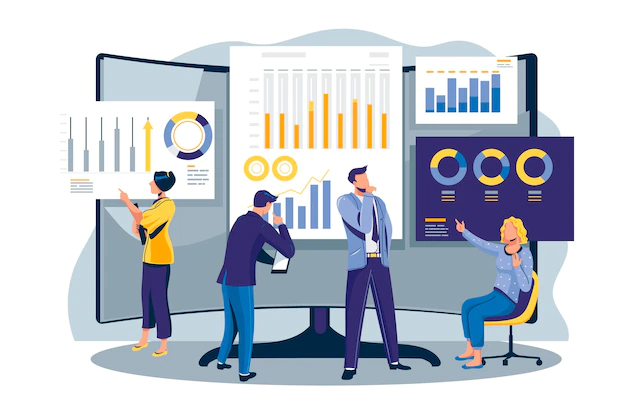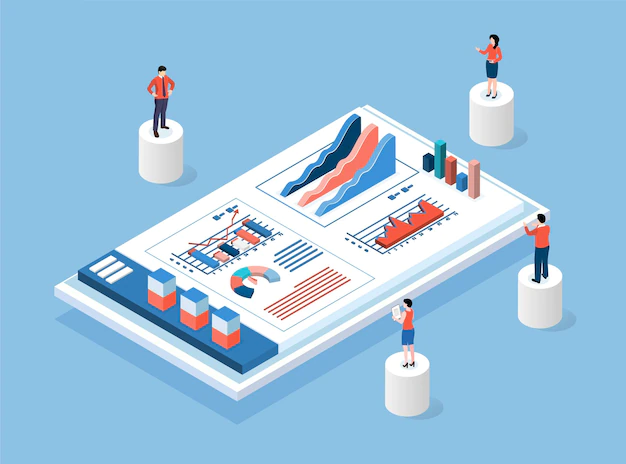
The Genesis of Tableau8
In 2003, a research endeavor at Stanford University led to the creation of Tableau. Chris Stolte, Christian Chabot, and Pat Hanrahan founded it with the goal of democratizing data analysis by harnessing the power of visualizations. Since the initial release of Tableau in 2005, the program has undergone substantial development to rise to the top of the market for Data visualization and Data modeling solutions.
Introduction:-
Tableau has become a forerunner in the fields of analysis of data and business intelligence, altering the way businesses see and analyze their data. The demand for advanced data visualization tools is greater than ever as both the amount and complexity of data continue to increase dramatically. This blog will examine the many facets of Tableau, its essential components, uses, and the effects it has had on companies in a range of sectors.
Tableau is a robust and popular business intelligence and visualization program created by Tableau Software, which recently became part of Salesforce. Users can connect data from numerous sources, evaluate it, and
engage with a visually pleasing visualization. Tableau makes data analysis available to users with and without technical skills with its simple user interface and drag-and-drop capability, allowing them to obtain insights and make data-driven decisions.
Key Features of Tableau:-
1) Data Connectivity: Tableau has the ability to connect to a wide range of data sources, including as databases, cloud services, large-scale data platforms, and more. Users are able to work with information coming from numerous sources because to this data integration.
2) Interactive Visualizations: A wide range of interactive visualizations, including charts with bars, line graphs, plots of scatter, heat maps, geographical maps, and more, are available in Tableau. Users only need to drag and drop fields of data onto the canvas to produce dynamic & captivating visualizations.
3) Dashboards and Storytelling: Users of Tableau can build interactive dashboards that offer a comprehensive picture of the data. The dashboards can be made interactive by users by adding filters, parameters, and actions. Users can also create compelling data tales and presentations using Tableau’s storytelling function.
4) Data Blending: Data blending, made possible by Tableau, enables users to integrate data from many sources without the requirement for data integration. When working with varying datasets, this functionality is especially helpful.
5) Advanced Analytics: Tableau delivers sophisticated analytics features like forecasting, predictive modeling, and statistical calculations. Users can carry out intricate calculations and learn more about their data.
6) Real-time Data Interaction: Real-time data interaction is supported by Tableau, allowing users to make connections with live data sources and view data as it is updated in real-time.
7) Collaboration and Sharing: Users can share dynamic dashboards, data visualizations, and results with other employees or stakeholders thanks to Tableau’s collaboration tools. This encourages conversations & decision-making based on data.

Core Features of Tableau:-
1) Data Connectivity and Integration: Tableau’s capacity to seamlessly link and interact with a variety of data sources is one of its main advantages. Tableau enables customers to import and combine data from various sources, including databases, excel, cloud services, and big data platforms, dissolving data silos and enabling thorough analysis.
2) Drag-and-Drop Interface: Tableau is used by users with and without technical expertise thanks to its drag-and-drop interface. Without the need for intricate coding or programming
knowledge, business and data analysts may easily construct visualizations by dropping and dragging fields of data onto the canvas.
3) Interactive Dashboards and Storytelling: Users may create captivating data narratives using Tableau’s interactive visualizations and storytelling features. Users can engage with
representations in real-time by using interactive components like filters, variables, and actions, creating a fun and immersive experience for exploring information and insight generation.
4) Advanced Analytics and Predictive Modeling: Users of Tableau are given the ability to move beyond static reports and historical analysis thanks to the incorporation of modern analytics and predictive modeling. Users can use machine learning algorithms, forecasting models, and statistical functions to produce data-driven predictions and find insightful information.
5) Extensive Visualizations: A wide range of visualizations, such as bar charts, graphs like lines, plots of scatter, heat maps, geographical maps, and more, are available in Tableau. Users can create attractive reports and dashboards by altering the style, scheme of colors, and format of these graphics to fit their individual requirements.
Tableau’s Impact on Data-driven Decision Making:-
1) Democratizing Data Analysis: Data analysis has become more accessible thanks to Tableau’s user-friendly interface, which enables staff members from a variety of department and levels of expertise to access and evaluate data without heavily relying on data specialists. This data democratization encourages an environment that values data within firms and gives people at all levels the ability to make data-driven decisions.
2) Real-time Data Insights: Organizations may get immediate insights into their data because to Tableau’s ability to establish connections to live data sources. This makes it possible for firms to make decisions quickly and to react to shifting market circumstances and new business prospects.
3) Improved Data Collaboration: The collaboration capabilities of Tableau make it easier for teams and departments to collaborate and have data-driven discussions. Team members can benefit from each other’s assessments by sharing interactive reports and dashboards, which can help them make better decisions.
4) Identifying Trends and Patterns: The ability to visualize data in Tableau makes it simpler to see patterns, trends, and outliers in datasets. Tableau assists users in finding relationships and key insights that may not be obvious from raw data alone by displaying data visually.
5) Enhanced Data Presentation: Users using Tableau may produce aesthetically appealing and polished reports and presentations. This is essential because visualizations are easier for stakeholders and decision-makers to understand and act upon than conventional tabular reports.
Applications of Tableau Across Industries:-
1) Business and Sales Analytics: Tableau is frequently used for sales analytics, assisting companies in monitoring sales patterns, tracking key performance indicators (KPIs), and spotting growth prospects. Tableau can be used by sales teams to boost overall income creation and optimize their sales methods.
2) Marketing and Customer Insights: Tableau is used by marketers to track campaign results, evaluate consumer behavior, and find the most efficient distribution methods. Businesses may customize their marketing campaigns to target particular demographics and increase client retention with the help of Tableau’s insights.
3) Finance and Budgeting: Tableau helps with analyzing finances, budgeting, and forecasting in the finance industry. Financial experts may use Tableau to analyze financial data, track their financial well-being, and make wise decisions that will help them reach their financial goals.
4) Healthcare and Life Sciences: Tableau is essential to the life sciences and healthcare industries, enabling data visualization for analysis of patient outcomes, medical research, and pharmaceutical development. Making data-driven decisions enables healthcare providers to enhance patient care and allocate resources more effectively.
5) Education and Non-profit Organizations: Tableau is used in the education industry and by nonprofit organizations to track and evaluate student performance, keep an eye on program efficacy, and show stakeholders and contributors how initiatives are having an impact.
Tableau’s Future and Industry Trends:-
Tableau is probably going to keep changing as long as technology does to keep up with the shifting demands of the data industry. Future trends for Tableau could include the following:
1) Integration of (AI) and (ML): For automated data analysis and produce predictive insights, Tableau may combine AI and ML capabilities, enabling users to get deeper and more useful insights from their information.
2) Cloud-Based Solutions: Tableau’s cloud-based products are projected to rise in response to the rising popularity of computing in the cloud, giving consumers more adaptability and scalability when maintaining their data and visuals.
3) Mobile Accessibility: The mobile app for Tableau enables users to access visuals while on the go. The software might experience more advancements in the future, making it simpler for users to engage with their information on mobile devices.
Tableau and Advanced Excel Integration:-
Powerful analysis tools such as Tableau and Excel work well together in a variety of ways. Excel has sophisticated data processing and calculation features, whereas Tableau excels at displaying information and interactive dashboards. Here is how they can cooperate:
1) Data Preparation in Excel: Spreadsheet can be utilized to clean, layout, and modify the raw data before importing it into Tableau. Users may effectively prepare data for analysis in Tableau by using the extensive data manipulation features of Excel, such as filtering, sorting, and information validation.
2) Advanced Calculations in Excel: Users have the freedom to carry out intricate computations and data manipulations because to the variety of built-in tools and formulae in Excel. Excel may be used to perform these complex computations, which can then be easily imported into Tableau for display.
3) Data Aggregation and Pivoting: The pivot tables in Excel are an effective tool for gathering and summarizing data. Users can use Tableau for displaying the summarized data after creating pivot tables in Excel to gain important insights and provide a comprehensive perspective of the data.
4) What-If Analysis: What-if analysis is made possible by Excel’s “Goal Seek” and “Scenario
Manager” capabilities, which let users investigate various situations and gauge how they might affect results. Tableau may be used to show the outcomes of an Excel what-if analysis to aid with comprehension and decision-making.
5) Advanced Charting in Excel: To produce appealing visual representations of data, Excel offers a broad variety of advanced charting tools, such as waterfall graphs, 3D charts, and bubble charts. These graphs can be created by users in Excel, which they can then import into Tableau to use in interactive dashboards.
6) Excel Data Export and Integration: Users of Tableau can export dashboards and visualizations back to Excel, allowing for easy data transfer between the two applications. Users may now take advantage of the distinctive advantages of both Tableau or Spreadsheet in their information analysis process thanks to this connection.
Conclusion:-
In conclusion, Excel is still a formidable tool for data preparation, complex computations, and what-if analysis, even though Tableau excels in visualization of data and analytics. Users can gain from a thorough and reliable
approach to interpreting and visualizing data through the inclusion of Tableau and Excel in the data analysis workflow. The combination of these two technologies enables organizations to make data-driven choices with clarity and assurance, ensuring their competitiveness in a world that is becoming more and more data-centric.
Tableau has emerged as a guiding light in a world driven by data where overload of information is a continual struggle, enabling organizations to understand their data and make wise decisions. Data analysis has been
more accessible to all thanks to its user-friendly design, data interactive dashboards, and powerful analytical
capabilities. Organizations can unlock the full potential of their data, obtain useful insights, and maintain a competitive edge in a market that is constantly changing by utilizing Tableau’s strong features and functions. As
we look to the future, Tableau’s ongoing innovation will undoubtedly alter data visualization and be a crucial factor in establishing the future’s data-driven environment.
